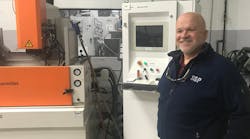2019 IW Best Plants Winner: A Fitting Transformation for SSP
SSP Fittings Corp. in Twinsburg, Ohio, is no newcomer to transformation. The first wave of change for the manufacturer of specialty stainless-steel fittings and valves happened in the 1970s, when Raymond King, father of current CEO David King, transformed the company from a job shop to a manufacturer of high-performance fittings.
The second wave occurred in the 1990s, when eight- to 12-week lead times from offshore suppliers compelled SSP to develop in-house diemaking and specialty cutting tool and forging capabilities. “The specialty tool integration was very important,” says David King. “That’s where the black magic is in our business.” The third wave happened in the early 2000s, when the company embarked on its lean journey that continues today.
But around 2010, in order to operate at a higher level, there was more transforming to tackle. Machine setup times that could stretch to 10 or 12 hours were a hindrance to a company whose niche was small production runs; its competitors are much larger companies that strictly do standardized, high-volume orders.
Safety was also an issue, with some parts fed into the multi-spindle machines by hand and heavy lifting bringing back and hand injuries. Communication between departments and managers and employees was inconsistent and inefficient. And due to a lack of inventory planning, SSP’s skilled workforce racked up plenty of overtime during the busy season but during slow times was sometimes relegated to doing busy work like painting the building.
We’ve had manufacturing excellence here for a long time, but we didn’t have planning excellence,” says King, who took over leadership of the company in 2016. “To put it into perspective, we offer 10,000-plus SKUs. So there’s a lot of variability, and several hundred parts that make up the majority of our volume. To be able to plan for this many parts was a level of sophistication we didn’t have.” (About two-thirds of SSP’s business is instrumentation fittings and valves, much of it for the energy industry).
Company leadership put together a plan to strategically upgrade equipment, maximizing efficiency and improving safety. It also built up its manufacturing engineering department, bringing in new expertise to rethink processes. “We had to develop those professional competencies within the organization, in order to adopt and apply the equipment,” says King.
Meet the IW Best Plants Award winners at Manufacturing & Technology 2020, an IndustryWeek event.
In the past seven years, SSP has invested $7.5 million in equipment upgrades. The company looked for equipment that was versatile and could change up quickly, had few touch points (for safety) and is easier to train on than older machines with lots of moving parts. All told, they’ve retired 91 pieces of major equipment—nearly 100%—during that time.
To optimize scheduling, planners split the plant into four areas—from high to low volume—and have a tailored scheduling system around each. The high-volume area is almost all make-to-stock, while at the other end of the building, the low-volume area with very little inventory buffer but thousands of SKUs, is mostly make-to-order.Manufacturing engineers work on grouping and sequencing jobs in a manner that makes machine changeovers as efficient as possible. High-volume rotary transfer machines, for example, are loaded up with like items that are grouped and run together, with incremental changes throughout the run. At automotive or ammunition plants, such machines run hundreds of thousands of the same unit, sometimes one part all year long. Not so at SSP. “We’re doing multiple setups—sometimes several setups a day on these machines,” says Paul Omilion,” SSP’s vice president of manufacturing.
“A lot of these parts used to go to multiple machines,” adds Omilion. “And now we’re doing it all on one machine. Parts come off the machine, get washed and run over to assembly to be assembled.”
On the human side of things, SSP has implemented an open-door policy with continuous communication between associates and their supervisors, upper-level management and human resources. The front office has been remodeled to more of an open-office plan with collaboration areas to encourage interaction and innovation. Managing for Daily Improvement meetings and weekly tactical meetings encourage just-in-time feedback. Performance goals and values, which used to be different from department to department, are now aligned throughout the company.
Additionally, an employee suggestion program saved the company over $200,000 in 2018 alone. Employees receive cross-training and tuition reimbursement, and in 2018 earned seven days’ additional pay in profit-sharing.
SSP is also working to lower its turnover rate by increasing compensation reviews in an employee’s first two years from three to five reviews, with a pay increase after each positive review.
The payoff from this transformation? Nearly $1.1 million in cost-savings in a single year. A 319% increase in earnings before interest and taxes. And a stellar safety record, with more than 7 million manhours without a lost-time accident.
Look for more improvements to come. “It’s like lean,” says King. “It’s a journey, not a destination. We’re constantly evaluating the best equipment meant to provide the best quality product and the safest way possible to get it to our customers.”
(Interested in participating in the 2020 IW Best Plants Awards competition? Register here.)
Main photo: SSP vice president of manufacturing Paul Omilion has been with the company for 27 years.Inside photo: Much of SSP’s workforce had little to no manufacturing experience when they started, but had math and computer aptitude and were trained quickly on the machines.





